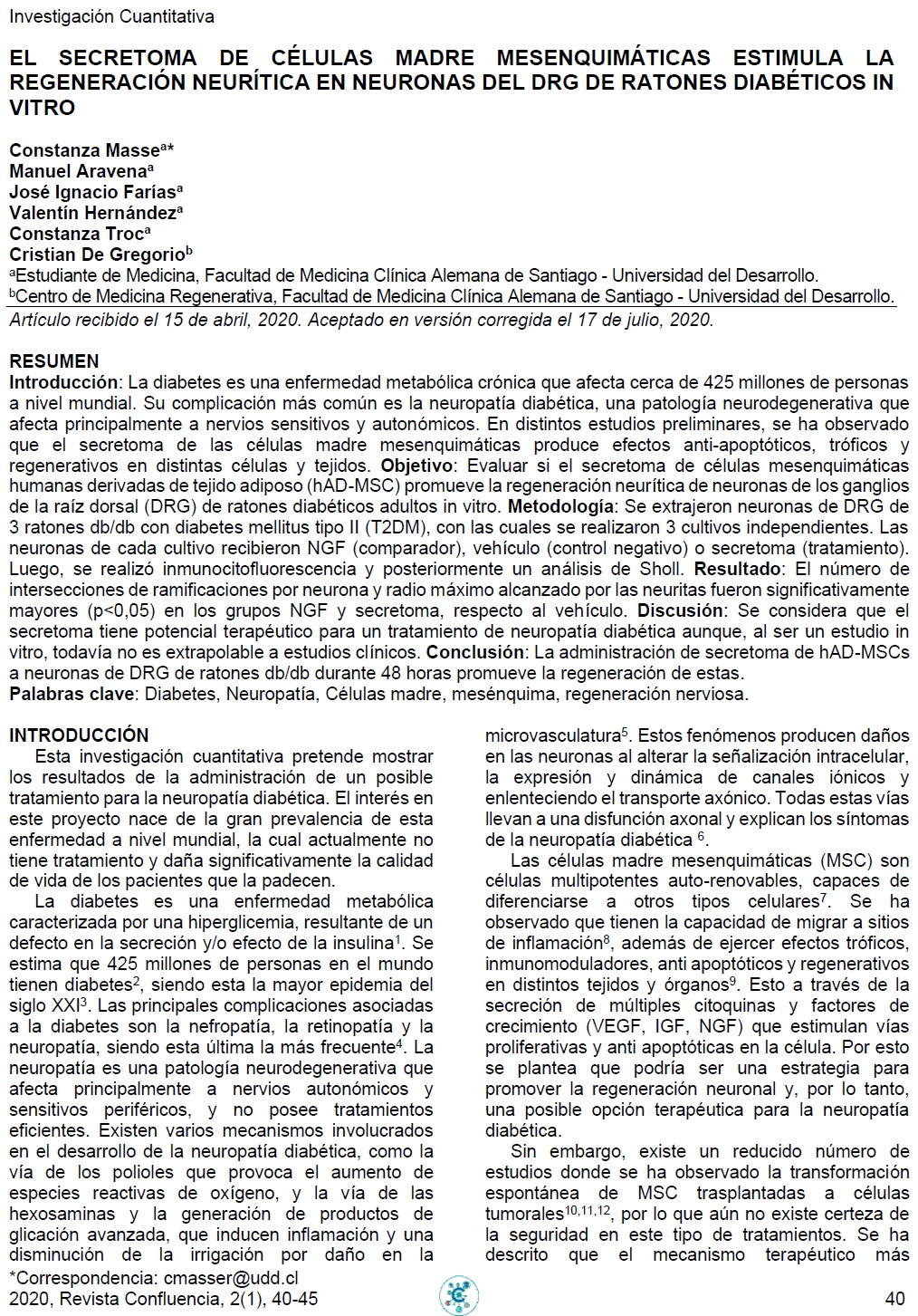El secretoma de células madre mesenquimáticas estimula la regeneración neurítica en neuronas del DRG de ratones diabéticos in vitro
DOI:
https://doi.org/10.52611/confluencia.num1.2020.499Keywords:
Diabetes, Neuropatía, Células madre, mesénquima, regeneración nerviosaAbstract
Introducción: La diabetes es una enfermedad metabólica crónica que afecta cerca de 425 millones de personas a nivel mundial. Su complicaciónmáscomu?n es la neuropati?a diabe?tica, una patologi?a neurodegenerativa que afecta principalmente a nervios sensitivos y autono?micos. En distintos estudios preliminares, se ha observado que el secretoma de las ce?lulas madre mesenquima?ticas produce efectos anti-apopto?ticos, tro?ficos y regenerativos en distintas ce?lulas y tejidos. Objetivo: Evaluar si el secretoma de células mesenquimáticas humanas derivadas de tejido adiposo (hAD-MSC) promueve la regeneración neuri?tica de neuronas de los ganglios de laraíz dorsal (DRG)de ratones diabéticos adultos in vitro. Metodología: Se extrajeron neuronas de DRG de 3 ratones db/db con diabetes mellitus tipo II (T2DM), con las cuales se realizaron 3 cultivos independientes. Las neuronas de cada cultivo recibieron NGF (comparador), vehi?culo (control negativo) o secretoma (tratamiento). Luego, se realizó inmunocitofluorescencia y posteriormente un ana?lisis de Sholl. Resultado: El nu?mero de intersecciones de ramificaciones por neurona y radio ma?ximo alcanzado por las neuritas fueron significativamente mayores (p<0,05) en los grupos NGF y secretoma, respecto al vehi?culo. Discusión: Se considera que el secretoma tiene potencial terapéuticopara un tratamiento de neuropati?a diabe?tica aunque, al ser un estudio in vitro, todavía no es extrapolable a estudios cli?nicos. Conclusión: La administración de secretoma de hAD-MSCs a neuronas de DRG de ratones db/db durante 48 horas promueve la regeneración de estas.
Downloads
References
American Diabetes Association. Diagnosis and Classification of Diabetes Mellitus. Diabetes Care [Internet]. 2010 [citado el 15 de agosto de 2019]; 33(Supplement 1):S62-S69. Disponible en: https://care.diabetesjournals.org/content/37/supplement_1/s81.short
International Diabetes Federation. IDF Diabetes Atlas 8a ed [Internet]. [citado el 15 de agosto de 2019]. Disponible en: https://diabetesatlas.org/en/
Tabish SA. Is diabetes becoming the biggest epidemic of the twenty-first century?. Int. J. Health Sci [Internet]. 2007 [citado el 18 de agosto de 2019];1(2)1,V-VIII. Disponible en: https://www.ncbi.nlm.nih.gov/pmc/articles/PMC3068646/
Lotfy M, Adeghate J, Kalasz H. Chronic Complications of Diabetes Mellitus: A Mini Review. Curr. Diabetes Rev [Internet]. 2017 [citado el 28 de septiembre de 2019]; 13(1):3-10. Disponible en: https://www.ingentaconnect.com/content/ben/cdr/2017/00000013/00000001/art00003
Feldman EL, Callaghan BC, Pop-Busui R, et al. Diabetic neuropathy. Nat. Rev. Dis. Primers [Internet]. 2019 [citado el 30 de agosto de 2019];5(1):1-18. Disponible en: https://www.nature.com/articles/s41572-019-0092-1
Cashman C, Höke A. Mechanisms of distal axonal degeneration in peripheral neuropathies. Neurosci. Lett. [Internet]. 2015 [citado el 2 de julio de 2020];596:33-50. Disponible en: https://doi.org/10.1016/j.neulet.2015.01.048
Kim EJ, Kim N, Cho SG. The potential use of mesenchymal stem cells in hematopoietic stem cell transplantation. Exp Mol Med [Internet]. 2013 [citado el 15 de agosto de 2019];45(1):e2-e2. Disponible en: https://www.nature.com/articles/emm20132
Kim N, Cho SG. Clinical applications of mesenchymal stem cells, Korean J Intern Med. [Internet]. 2013 [citado el 16 de agosto de 2019];28(4):387-402. Disponible en: https://www.ncbi.nlm.nih.gov/pmc/articles/PMC3712145/
Wakao S, Kuroda Y, Ogura F, et al. Regenerative Effects of Mesenchymal Stem Cells: Contribution of Muse Cells, a Novel Pluripotent Stem Cell Type that Resides in Mesenchymal Cells. Cells [Internet]. 2012 [citado el 28 de septiembre de 2019];1(4):1045-60. Disponible en: https://www.mdpi.com/2073-4409/1/4/1045
Lee HY, Hong IS. Double-edged sword of mesenchymal stem cells: Cancer-promoting versus therapeutic potential. Cancer Sci [Internet]. 2017 [citado el 15 de agosto de 2019];108(10):1939-46. Disponible en: https://onlinelibrary.wiley.com/doi/full/10.1111/cas.13334
Volarevic V, Simovic B, Gazdic M, et al. Ethical and Safety Issues of Stem Cell-Based Therapy. Int J Med Sci [Internet]. 2018 [citado el 26 de agosto de 2019]; 15(1):36-45. Disponible en: https://www.ncbi.nlm.nih.gov/pmc/articles/PMC5765738/
He L, Zhao F, Zheng Y, et al. Loss of interactions between p53 and surviving gene in mesenchymal stem cells after spontaneous transformation in vitro. Int J Biochem Cell Biol [Internet]. 2016 [citado el 18 de agosto de 2019];75:74-84. Disponible en: https://doi.org/10.1016/j.biocel.2016.03.018
Hofer HR, Tuan RS. Secreted trophic factors of mesenchymal stem cells support neurovascular and musculoskeletal therapies. Stem Cell Research Therapy [Internet]. 2016 [citado el 28 de septiembre de 2019];7(1):131. Disponible en: https://stemcellres.biome dcentral.com/articles/10.1186/s13287-016-0394-0
Krieglstein K, Strelau J, et al. TGF-b and the regulation of neuron survival and death. J. Physiol. Paris [Internet]. 2002 [citado el 3 de septiembre de 2019];96(1-2):25-30. Disponible en: https://doi.org/10.1016/S0928-4257(01) 00077-8
Sherr CJ, De Pinho RA. Cellular Senescence: Minireview Mitotic Clock or Culture Shock?. Cell [Internet]. 2000 [citado el 3 de septiembre de 2019];102(4);407-10. Disponible en: https://www.cell.com/fulltext/S0092-8674(00)00046-5
De Gregorio C, Ezquer F, Contador D. Human adipose-derived mesenchymal stem cell conditioned medium ameliorates polyneuropathy and foot ulceration in diabetic BKS db/db mice. Stem cell res ther. Por publicar, 2020.
De Gregorio C, Contador D, Campero M. Characterization of diabetic neuropathy progression in a mouse model of type 2 diabetes mellitus. BIOL OPEN [Internet]. 2018 [citado el 15 de agosto de 2019];7(9):bio036830. Disponible en: https://bio.biologists.org/content/7/9/bio036830.abstract
Sango K, Saito H, Takano M. Cultured Adult Animal Neurons and Schwann Cells Give Us New Insights into Diabetic Neuropathy. Curr. Diabetes Rev [Internet]. 2006 [citado el 26 de agosto de 2019];2(2):169-83. Disponible en: https://www.ingentaconnect.com/content/ben/cdr/2006/00000002/00000002/art00004
Ferreira T, Blackman A, Oyer J. Neuronal morphmetry directly from bitmap images. Nat. Methods [Internet]. 2014 [citado el 18 de agosto de 2019];11(10):982-4. Disponible en: https://www.nature.com/articles/nmeth.3125/
Katsetos CD, Legido A, Perentes E, Mörk SJ. Class III β-Tubulin Isotype: A Key Cytoskeletal Protein at the Crossroads of Developmental Neurobiology and Tumor Neuropathology. J. Child Neurol [Internet]. 2003 [citado el 28 de septiembre de 2019];18(12),851-66. Disponible en: https://doi.org/10.1177/088307380301801205
Nguyena S, Lievena C & Levinab L. Simultaneous labeling of projecting neurons and apoptotic state. J of Neuroscience Methods [Internet]. 2007 [citado el 26 de agosto de 2019];161(2):281-4. Disponible en: https://doi.org/10.1016/j.jneumeth.2006.10.026
Hall A. Rho GTPases and the actin cytoskeleton. Sci [Internet]. 1998 [citado el 3 de octubre de 2019]; 279(5350):509-14. DOI: 10.1126/science.279.5350.509
Bradke F, Fawcett JW, Spira ME. Assembly of a new growth cone after axotomy: the precursor to axon regeneration. Nat. Rev. Neurosci [Internet]. 2012 [citado el 18 de agosto de 2019];13(3):183-93. Disponible en: https://www.nature.com/articles/nrn3176
Vogelbaum M, Tong J, Rich K. Developmental Regulation of Apoptosis in Dorsal Root Ganglion Neurons. J. Neurosci [Internet]. 1998 [citado el 3 de octubre de 2019];18(21):8928-35. Disponible en: https://www.jneurosci.org/content/18/21/8928.short
LeClair RJ, Durmus T, et al. Cthrc1 Is a Novel Inhibitor of Transforming Growth Factor-β Signaling and Neointimal Lesion Formation. Circ. Res [Internet]. 2007 [citado el 10 de octubre de 2019];100(6):826-33. Disponible en: https://www.ahajournals.org/doi/full/10.1161/01.RES.0000260806.99307.72
Oses C, Olivares B, Ezquer M, et al. Preconditioning of adipose tissue-derived mesenchymal stem cells with deferoxamine increases the production of pro-angiogenic, neuroprotective and anti-inflammatory factors: Potential application in the treatment of diabetic neuropathy. PLoS One [Internet]. 2017 [citado el 15 de agosto de 2019];12(5):e0178011. Disponible en: https://www.ncbi.nlm.nih.gov/pmc/articles/PMC5438173/
Andrius Kaselis A, Treinys R, Vosyliute R. DRG Axon Elongation and Growth Cone Collapse Rate Induced by Sema3A are Differently Dependent on NGF Concentration. Cell Mol Neurobiol [Internet]. 2014 [citado el 10 de octubre de 2019];34(2):289-96. Disponible en: https://link.springer.com/article/10.1007/s10571-013-0013-x
Zhou J, Zhang Z, Qian G. Mesenchymal stem cells to treat diabetic neuropathy: a long and strenuous way from bench to the clinic. Cell Death Discov [Internet]. 2016 [citado el 7 de noviembre de 2019];2(1):1-7. Disponible en: https://www.nature.com/articles/cddiscovery201655
Gensel J, Schonberg D, Alexander J, et al. Semi-automated Sholl analysis for quantifying changes in growth and differentiation of neurons and glia. J Neuroscience Methods [Internet]. 2010 [citado el 15 de agosto de 2019];190(1):71-79. Disponible en: https://doi.org/10.1016/j.jneumeth.2010.04.026
Apfel SC. Nerve growth factor for the treatment of diabetic neuropathy: What went wrong, what went right, and what does the future hold? Int. Rev. Neurobiol. 2002 [citado el 28 de septiembre de 2019];50:393-413.

Downloads
Published
How to Cite
Issue
Section
License
Copyright (c) 2020 Revista Confluencia

This work is licensed under a Creative Commons Attribution-NonCommercial-NoDerivatives 4.0 International License.








